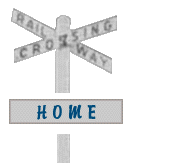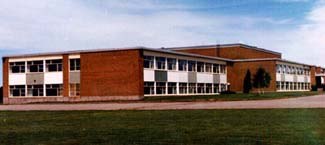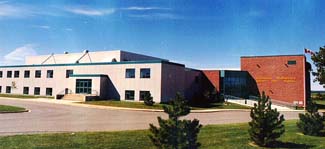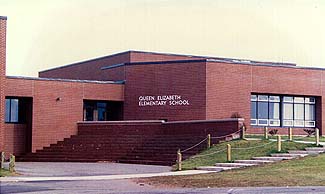









While the Kensington region has a long school history, dating back to 1794, its schools did not start to offer grades 11 and 12 until 1955. If anyone from the community wanted to seek a higher than grade 10 education, he or she would have to board away from home, most likely in Charlottetown. Obtaining this level of education was of great expense, due to boarding costs and often due to the fact that it meant losing an extra hand on the farm. Going to college was certainly not the common course of events as it is today.
 During the first half
of the twentieth century, there were two post-secondary
institutions on the Island: the Catholic-based St.
Dunstan's University, and the predominantly Protestant
Prince of Wales College. The two schools eventually
merged in 1969 to become the University of Prince Edward
Island. St. Dunstan's also operated a high school which
prepared students for university studies. While St.
Dunstan's was at one time all male, the doors were opened
to women after Gertrude Butler went to the bishop-- also
the university chancellor-- and asked for the right to
attend. Even so, one female student from Kensington,
Patricia Pendergast, was the only female in her class at
St. Dunstan's University in her graduating year. Over the
years, however, the Sisters of St. Martha began to
operate a boarding house for girls located across from
the university and there were many female students
graduating in the years which followed.
During the first half
of the twentieth century, there were two post-secondary
institutions on the Island: the Catholic-based St.
Dunstan's University, and the predominantly Protestant
Prince of Wales College. The two schools eventually
merged in 1969 to become the University of Prince Edward
Island. St. Dunstan's also operated a high school which
prepared students for university studies. While St.
Dunstan's was at one time all male, the doors were opened
to women after Gertrude Butler went to the bishop-- also
the university chancellor-- and asked for the right to
attend. Even so, one female student from Kensington,
Patricia Pendergast, was the only female in her class at
St. Dunstan's University in her graduating year. Over the
years, however, the Sisters of St. Martha began to
operate a boarding house for girls located across from
the university and there were many female students
graduating in the years which followed.
By 1955, the 1903 Kensington school
was filled to capacity, with 300 students and 11 teachers
crammed into what was originally only a four-room
structure. A new high school was built that year, and
grades eleven and twelve began to be offered here in the
town. The new school was state-of-the-art for its day and
age, containing such lavish facilities as a kitchen, an
auditorium, and a  library. This building
eventually became the elementary school when the new
Kensington Regional High School was built in 1963.
library. This building
eventually became the elementary school when the new
Kensington Regional High School was built in 1963.
The reason why this new high school was built so soon-- almost before the paint dried on the other building-- was the process of school amalgamation which had started across the Island. The education system began to shift from small, even one-room schools to larger regional centres, with more students but also more modern educational facilities. While smaller communities lost their schools, it was hoped that these students would gain from access to chemistry labs, libraries, and gymnasiums. The new Kensington High was built to accommodate the upper-grade students from twenty outlying school districts, who were bussed into town to attend classes. By the early 1970's, there were 600 students attending classes in the school, instructed by thirty-one teachers. Due to fluctuations in age-group numbers and outmigration from the area, the number has dropped on occasion to under 400 students. But the student population has stabilized and even increased in recent years, and there are now 440 students and twenty-six teachers within the school walls.
 Today, schools are
changing faster than ever before, and by the 1980s, major
renovations were needed to keep the quality of education
in Kensington up to par with other institutions. In 1988,
the school received a 6.7 million dollar expansion that
added approximately forty thousand square feet to the
facility. Intermediate students, who until this point had
been taught at the 1955 school, were also moved into the
new and improved high school. In addition to providing a
solid education to its students, Kensington
Intermediate-Senior High has continued to be a focal
point for the entire town, where residents gather for
concerts, basketball games, and to take Community School
programs themselves. The importance of the school to
Kensington cannot be underestimated, as the building
provides not only a venue for gatherings of all sorts but
also acts a visible symbol of community spirit.
Today, schools are
changing faster than ever before, and by the 1980s, major
renovations were needed to keep the quality of education
in Kensington up to par with other institutions. In 1988,
the school received a 6.7 million dollar expansion that
added approximately forty thousand square feet to the
facility. Intermediate students, who until this point had
been taught at the 1955 school, were also moved into the
new and improved high school. In addition to providing a
solid education to its students, Kensington
Intermediate-Senior High has continued to be a focal
point for the entire town, where residents gather for
concerts, basketball games, and to take Community School
programs themselves. The importance of the school to
Kensington cannot be underestimated, as the building
provides not only a venue for gatherings of all sorts but
also acts a visible symbol of community spirit.
Elementary students where taught at the 1955
school until 1976, when the Queen Elizabeth school-- the
sixth school built in Kensington's history-- was
completed. Many of the schools in outlying communities
had  continued
to teach the primary grades until the mid-1970s, when the
process of amalgamation began in the elementary schools.
After these schools were closed up, the children from the
rural communities started being bussed to Queen Elizabeth
Elementary School. At the most recent count, the school
had twenty-six teachers and 475 students between grades
one and six.
continued
to teach the primary grades until the mid-1970s, when the
process of amalgamation began in the elementary schools.
After these schools were closed up, the children from the
rural communities started being bussed to Queen Elizabeth
Elementary School. At the most recent count, the school
had twenty-six teachers and 475 students between grades
one and six.
Today, Kensington Regional High and Queen Elizabeth Elementary make up the Kensington family of schools, part of the Western School Board on the Island. Local administrators and parents continue to work long and hard to make education in the Kensington school family as good as-- or better than-- schooling in the rest of the province. While these schools themselves are the end result of amalgamation, moving from one-room schools to regional centres, it is highly unlikely that they would ever allow the area to lose its schools. If the schools ever went, some say, the community would soon follow. But based on the local support its schools receive, this is a risk Kensington will not be taking.
